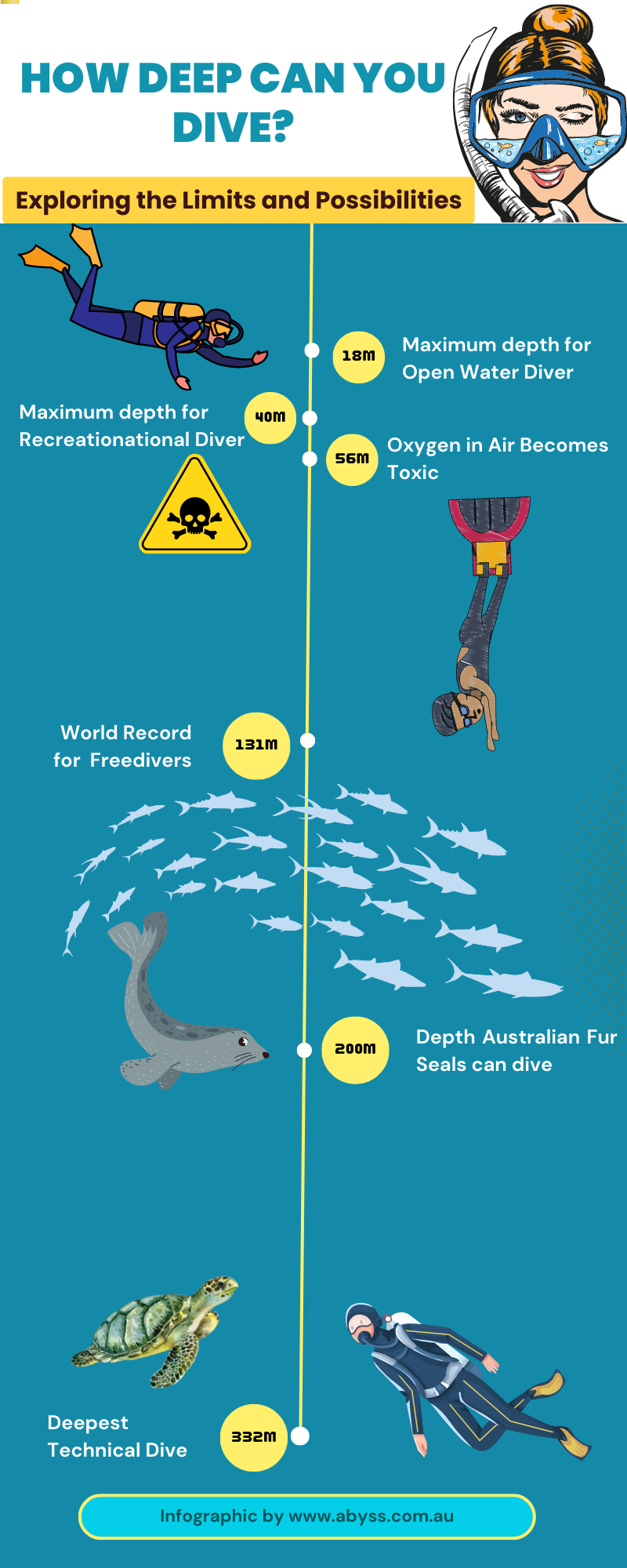You have 0 product(s) in your cart.
Abyss Scuba Diving
Mastering The Art Of The Deep Dive: An In-depth Exploration Guide
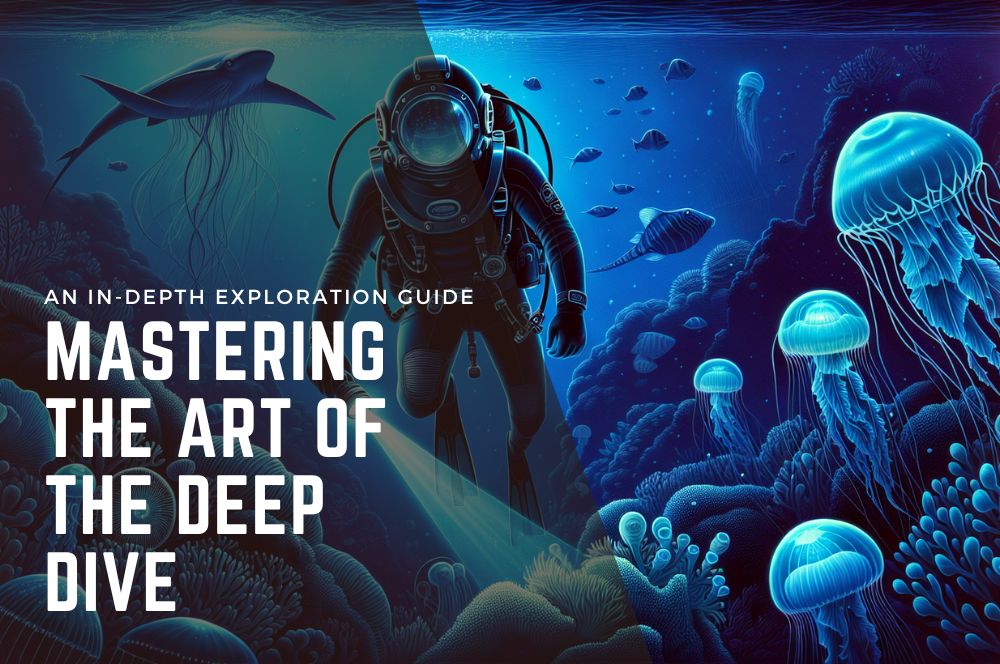
Mastering the Art of the Deep Dive: An In-Depth Exploration Guide
Deep diving is an exhilarating journey below the ocean’s surface where specialized knowledge becomes vital for your safety. You’re about to understand how to mitigate deep diving risks like nitrogen narcosis and decompression sickness, and how to equip for the extreme underwater pressure. This guide aims to clearly lay out the specific preparation, training, and techniques essential for a successful deep dive—without delving into unnecessary detail. Expect practical insights and actionable advice tailored for divers ready to explore depths beyond recreational limits.
Key Takeaways
-
Deep diving, characterized by descending beyond the typical recreational limits of 18 to 30 meters, involves increased risks such as nitrogen narcosis, oxygen toxicity, decompression sickness, and requires specialized equipment and training.
-
Comprehensive training and certification like the PADI Deep Diver course are crucial for preparing divers for the unique challenges of deep diving, focusing on gas management, dive planning, safety procedures, and skills development.
-
Technical diving exceeds standard recreational diving limits, exploring beyond 40 meters with decompression requirements using advanced techniques and equipment such as helium mixes and rebreathers to mitigate deep diving risks.
Defining Deep Diving: Beyond Recreational Limits
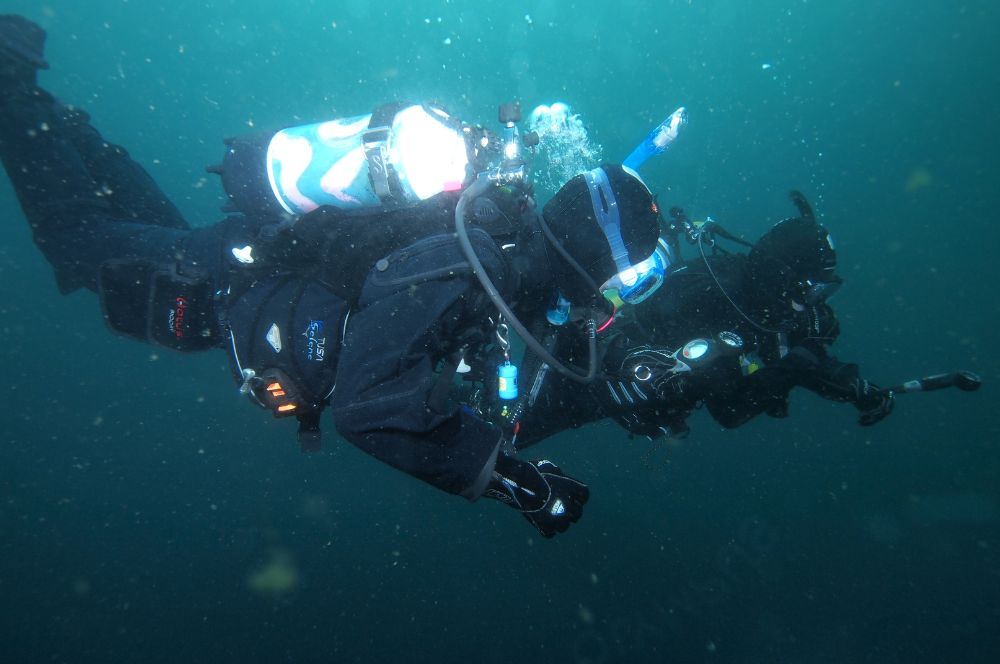
To set the stage, let’s first define what we mean by “deep diving”. While recreational diving typically extends to depths of 18 to 30 meters, deep diving is generally regarded as venturing beyond this threshold. It’s a realm where the standard recreational limits are left behind and divers plunge into greater depths, with certification typically awarded for dives that extend below 30 meters. This definition provides a framework for understanding deep diving, distinguishing it from the more familiar realm of recreational diving.
In the commercial diving industry, the definition of deep diving takes on a slightly different connotation. Here, deep diving is defined not only by the depth but also by the need for specialized equipment or advanced training due to the greater depths involved. This illustrates the diversity in the field of diving and the varying standards in different sectors of the industry.
The Risks and Challenges of Deep Dives

As we venture deeper into the aquatic world, the risks and challenges we encounter escalate. Deep diving encompasses a range of potential hazards including:
-
Decompression sickness
-
Oxygen toxicity
-
High-pressure nervous syndrome
The pressure experienced during a deep dive increases by an additional atmosphere every 10 meters, leading to complications such as nitrogen narcosis, which impairs cognitive and motor functions, and oxygen toxicity at greater depths. It’s a stark reminder of the inherent dangers of deep diving and the need for thorough preparation and training.
To put these risks into perspective, consider the fact that worldwide, there are approximately 100 freediving fatalities each year, with an annual loss rate of 54 per 100,000 participants. These statistics underscore the seriousness of the risks associated with deep diving. However, with the right training and safety measures, these risks can be significantly mitigated, which we will discuss further in the following sections.
Now, let’s dive deeper (pun intended) into these risks, starting with one of the most significant effects of a deep dive - the pressure effects on the body.
Pressure Effects on the Body
As we descend beneath the water’s surface, we enter a world governed by the laws of physics. At sea level, the pressure exerted on our bodies is 1 bar, but diving just 10 meters underwater doubles this pressure. For every additional 10 meters of descent, the pressure on a diver’s body increases by about 100 kPa. This means that at 30 meters, a diver experiences pressure three times that at sea level, and this continues to increase with depth.
The effects of this pressure are not merely theoretical. According to Boyle’s Law, the volume of gas is inversely proportional to the pressure when the temperature remains constant. This causes the volume of air in a diver’s body to reduce as depth increases. Air spaces within the diver’s body, like:
-
ears
-
mask
-
sinuses
-
lungs
must be equalized to accommodate the increased pressure and decreased air volume while descending. Additionally, divers must continuously exhale during ascent to prevent lung expansion injuries due to the decreasing pressure and expanding air that was breathed at depth. Understanding and managing these pressure effects are fundamental to safe deep diving.
Gas Management and Narcosis
As we delve deeper into the ocean’s depths, the need for proper gas management becomes increasingly crucial. Nitrogen narcosis, a condition that occurs at depths as shallow as 30 meters, is characterized by a change in the level of consciousness similar to the sensation of intoxication. Symptoms of nitrogen narcosis include:
-
impaired judgment
-
impaired reasoning
-
impaired memory
-
impaired concentration
These symptoms can advance to stupor or coma with increasing depth, though they are not progressive with time at a constant depth.
During a deep dive, breathing compressed inert gases leads to changes in consciousness and neuromuscular function, with the potential for unconsciousness at depths near 100 meters. Proper gas management, particularly below 60 meters where hypoxic breathing gas must be used, is essential to avoid oxygen toxicity. This is due to the increased partial pressures of nitrogen in the bloodstream.
Effective gas management, therefore, is a crucial aspect of deep diving, underscored by the potential risks of narcosis and oxygen toxicity.
Decompression Sickness and Oxygen Toxicity
But the challenges of deep diving don’t end with narcosis. As we descend further, divers also face risks of oxygen toxicity and decompression sickness. Oxygen toxicity, also known as hyperoxia, arises when divers breathe air with elevated oxygen partial pressures, which can be encountered at certain depths. When divers are subjected to pressures exceeding 160 kPa, the risk of acute oxygen toxicity increases, potentially leading to severe and rapid health complications such as:
-
convulsions
-
seizures
-
loss of consciousness
-
pulmonary edema
It is important for divers to be aware of these risks and take necessary precautions to ensure their safety.
At extreme depths, a lung full of a gas mixture with 2% oxygen results in approximately six times more oxygen molecules being dissolved in the diver’s blood than at sea level. According to Henry’s Law, the deeper a diver goes, the more oxygen dissolves into their bloodstream, increasing the risk of decompression sickness due to higher concentrations of gases. These risks illustrate the need for divers to understand and manage the physiological effects of deep diving.
Preparing for Deep Diving: Training and Certification
Having discussed the risks and challenges of deep diving, it’s clear that comprehensive training and certification are essential for anyone looking to venture beyond recreational limits. These training programs, such as the PADI Deep Diver course, prepare divers for the unique challenges of deep diving, providing them with the necessary skills, knowledge, and experience to dive safely and confidently.
These courses are comprehensive, covering everything from equipment handling and gas management to dive planning and emergency procedures. Let’s dive into the details of these courses, starting with the prerequisites and requirements for enrollment.
Course Prerequisites and Requirements
To enroll in the PADI Deep Diver course, participants must be at least 15 years old and hold a PADI Adventure Diver certification or have a qualifying certification from another training organization. This ensures that those enrolling in the course have a basic level of experience and skill in diving, preparing them for the more advanced challenges of deep diving.
But it’s not just about having the right certification. Individuals interested in the PADI Deep Diver course should:
-
Be proficient swimmers and comfortable in the water to ensure safety and success
-
Complete a medical questionnaire to ascertain good physical health before starting the course
-
Have complete comfort with shallow water dives and have their gear in proper condition prior to progressing to deep diving experiences
This helps ensure that divers are physically and mentally prepared for the rigors of deep diving.
Course Content and Skills Development
The PADI Deep Diver course provides comprehensive knowledge in managing gas supply, deep dive planning, and using specialized equipment for deep dives. This course combines independent study through PADI eLearning with practical hands-on exercises during four dives under the guidance of a PADI Instructor. This blend of theoretical and practical learning ensures that divers are well-equipped to handle the challenges of deep diving.
Students in the PADI Deep Diver course learn to plan and execute deep dives, manage potential narcosis, and practice descents, buoyancy control, and safety stops. Upon completion of the course, participants receive the PADI Deep Diver Specialty Certification. This certification is a testament to their skills and competence in deep diving, preparing them for the exciting experiences that await in the depths of the ocean.
Becoming a Certified Deep Diver
Becoming a certified deep diver is a process that requires commitment, patience, and a keen desire to explore the unknown. The PADI Deep Diver course comprises independent study, academic lessons, and a practical component consisting of four dives on the Ex-HMAS Brisbane wreck. This combination of theoretical and practical learning equips divers with the knowledge and experience they need to handle the rigors of deep diving.
To achieve the Deep Diver certification, participants must complete the course over at least two days and successfully perform four dives under the guidance of a certified PADI Instructor. Once certified, divers are qualified to safely dive to a maximum depth of 40 meters. This certification serves as a passport to the deeper realms of the ocean, opening up a world of exploration and adventure.
Technical Diving: Pushing the Boundaries
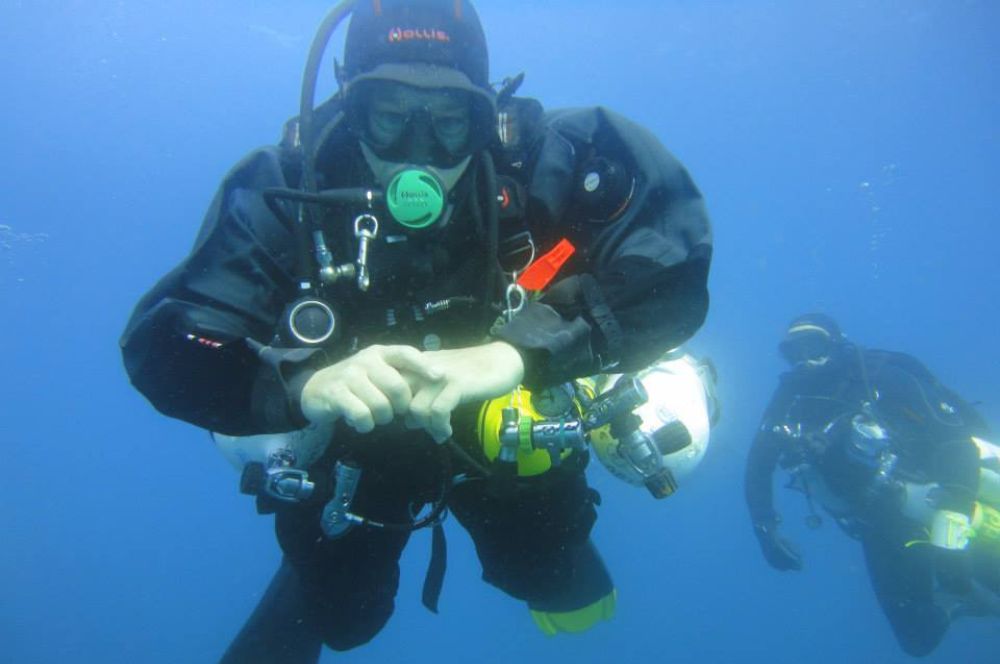
Having discussed the risks and challenges of deep diving, it’s clear that comprehensive training and certification are essential for anyone looking to venture beyond recreational limits. These training programs, such as the PADI Deep Diver course, prepare divers for the unique challenges of deep diving, providing them with the necessary skills, knowledge, and experience to dive safely and confidently.
These courses are comprehensive, covering everything from equipment handling and gas management to dive planning and emergency procedures. Let’s dive into the details of these courses, starting with the prerequisites and requirements for enrollment.
Course Prerequisites and Requirements
To enroll in the PADI Deep Diver course, participants must be at least 15 years old and hold a PADI Adventure Diver certification or have a qualifying certification from another training organization. This ensures that those enrolling in the course have a basic level of experience and skill in diving, preparing them for the more advanced challenges of deep diving.
But it’s not just about having the right certification. Individuals interested in the PADI Deep Diver course should:
-
Be proficient swimmers and comfortable in the water to ensure safety and success
-
Complete a medical questionnaire to ascertain good physical health before starting the course
-
Have complete comfort with shallow water dives and have their gear in proper condition prior to progressing to deep diving experiences
This helps ensure that divers are physically and mentally prepared for the rigors of deep diving.
Course Content and Skills Development
The PADI Deep Diver course provides comprehensive knowledge in managing gas supply, deep dive planning, and using specialized equipment for deep dives. This course combines independent study through PADI eLearning with practical hands-on exercises during four dives under the guidance of a PADI Instructor. This blend of theoretical and practical learning ensures that divers are well-equipped to handle the challenges of deep diving.
Students in the PADI Deep Diver course learn to plan and execute deep dives, manage potential narcosis, and practice descents, buoyancy control, and safety stops. Upon completion of the course, participants receive the PADI Deep Diver Specialty Certification. This certification is a testament to their skills and competence in deep diving, preparing them for the exciting experiences that await in the depths of the ocean.
Becoming a Certified Deep Diver
Becoming a certified deep diver is a process that requires commitment, patience, and a keen desire to explore the unknown. The PADI Deep Diver course comprises independent study, academic lessons, and a practical component consisting of four dives on the Ex-HMAS Brisbane wreck. This combination of theoretical and practical learning equips divers with the knowledge and experience they need to handle the rigors of deep diving.
To achieve the Deep Diver certification, participants must complete the course over at least two days and successfully perform four dives under the guidance of a certified PADI Instructor. Once certified, divers are qualified to safely dive to a maximum depth of 40 meters . This certification serves as a passport to the deeper realms of the ocean, opening up a world of exploration and adventure.
Record-Breaking Deep Dives
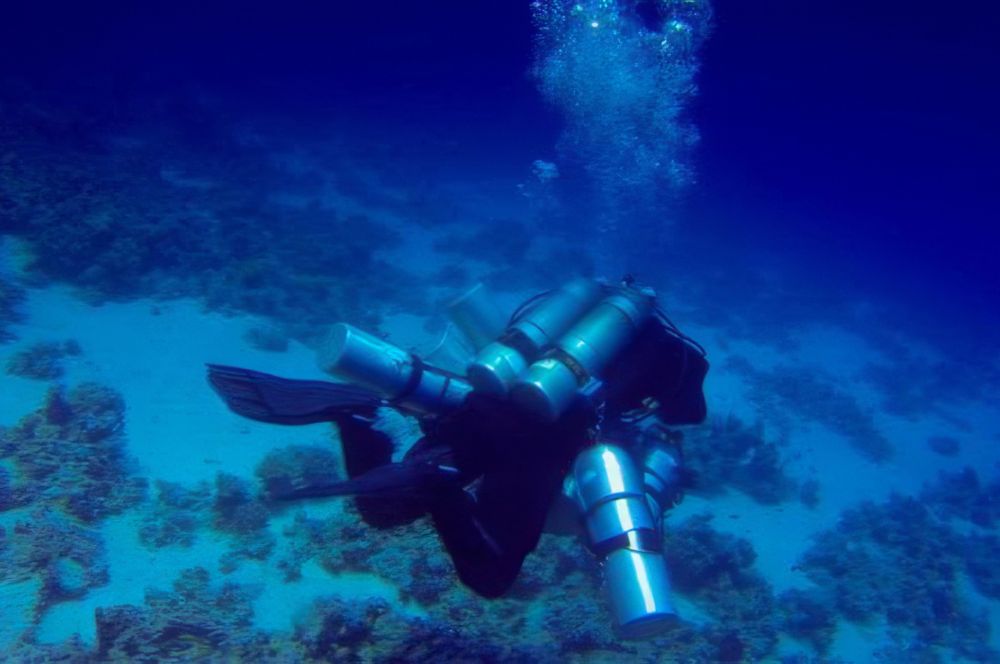
Deep diving is not just about exploration and adventure; it’s also a field where records are made and broken. The deepest scuba dive in open water was performed by Ahmed Gabr in 2014, reaching a staggering depth of 332.35 meters. On the other hand, the men’s world record for Constant Weight freediving depth is held by Alexey Molchanov, who reached an astonishing 131 meters in 2021, surpassing his own previous record of 130 meters set in 2018. These record-breaking dives serve as inspiring feats of human endurance and adaptability, pushing the limits of what’s possible in the realm of deep diving.
Tips for a Safe and Successful Deep Dive
Deep diving, while exhilarating, is a pursuit that demands caution and careful preparation. Following a well-considered dive plan, including ascent timing and adherence to predetermined depth and air limits, is fundamental for dive safety. Getting ample rest before the dive day, reducing consumption of alcohol and caffeine, and ensuring proper hydration can minimize the risks of decompression sickness and inattention.
Practicing caution and integrating safety rules into the diving routine can prevent distress and hazards, especially for beginners. Now, let’s delve deeper into the specifics of planning, communication, and adaptability in ensuring a safe and successful deep dive.
Proper Planning and Preparation
Proper planning and preparation are cornerstones of safe and successful deep diving. Here are some key steps to follow:
-
Develop a detailed dive plan, including route, dive times, planned depth, and air consumption limits.
-
Incorporate adaptations for expected water conditions, such as temperature and visibility.
-
Set out clear communication signals and emergency procedures.
By following these steps, you can create a safe and successful deep dive experience.
Before embarking on a deep dive, divers should:
-
Assess their physical and mental readiness
-
Understand their motivations
-
Check that surface support is available
-
Carefully prepare all necessary equipment
Confirming that diving gear functions correctly and is familiar to the diver before going on deeper dives is crucial. This meticulous preparation helps ensure that divers are equipped to handle any situation they may encounter during their dive.
Buddy System and Communication
Diving with a buddy is a crucial aspect of deep diving safety. Here are some important considerations:
-
Diving with a buddy whose experience and comfort levels are taken into account is crucial for deep diving.
-
Establishing clear communication methods and lost buddy procedures is essential.
-
Choosing an appropriate diving buddy is essential for safety, allowing divers to support each other.
Underwater communication devices using ultrasonic waves enable divers to talk to each other, facilitating instructions and safety checks. Maintaining constant communication during deep dives with eye contact and established hand signals is key to operational safety. Divers should become accustomed to locating and using their buddy’s equipment, such as the BC inflator, alternate air source, and weight release, in emergency situations. Buddies can help each other face challenges such as navigating in low visibility, handling currents, or dealing with equipment issues.
Eye contact is a vital form of communication during deep dives, and partners should be prepared to abort the dive if one is in trouble.
Monitoring and Adapting to Conditions
Flexibility and adaptability are key to a safe and successful deep dive. Divers should:
-
Inspect the diving conditions beforehand
-
Be prepared to abort the dive if they feel uneasy or if conditions are not favorable
-
Constantly monitor buoyancy, breathing rate, and gauges
-
Be prepared to adapt, including starting the ascent earlier if needed
During an extensive deep dive, these precautions are necessary to ensure a safe and enjoyable experience.
Ascending safely from deep freedives typically requires an additional 3 minutes or longer depending on the depth of the dive. Divers are advised to be attuned to their own comfort levels and the water conditions, ready to end a dive if feeling uneasy. Diving in different water environments, such as warm Caribbean waters versus frigid waters elsewhere, requires an understanding of the unique factors at play in each. This adaptability, coupled with meticulous preparation and effective communication, can go a long way in ensuring a safe and successful deep dive.
Summary
As we emerge from the depths of this exploration into deep diving, it’s clear that this activity is a captivating blend of thrill, serenity, and challenge. From defining deep diving and understanding its risks and challenges to exploring the intricacies of training and certification, we’ve navigated the depths of this fascinating pursuit. We’ve also looked ahead to the future of deep diving, fueled by technological advancements and a deeper understanding of human physiology.
The world beneath the waves is a realm of mystery and beauty, waiting to be explored. Yet, it requires respect, preparation, and sound knowledge to navigate its depths safely and effectively. For those who dare to take the plunge, the journey is rewarding. As we push the boundaries, we not only explore the depths of the ocean but also the depths of our own courage and resilience. So gear up, get trained, and dive deep - the ocean’s depths await!
Frequently Asked Questions
What does deep dive mean slang?
In slang, "deep dive" refers to a thorough investigation or analysis of something, often used to describe comprehensive journalism.
What is a word for deep dive?
A word for a deep dive could be "in-depth exploration" or "comprehensive review." These terms convey the idea of thorough analysis.
What is the standard recreational limit for diving?
The standard recreational limit for diving is 18 meters (60 feet), so it's important to adhere to this depth for safety.
What is the PADI Deep Diver course?
The PADI Deep Diver course is a comprehensive program that trains divers to handle the challenges of deep diving and use specialized equipment effectively.
What is technical diving?
Technical diving is a form of scuba diving that goes beyond recreational limits, involving diving beyond 40 meters, required stage decompression, and operation in an overhead environment. It uses variable gas mixtures.
Related Posts
-
Mastering the Surf: Your Guide to Safe…
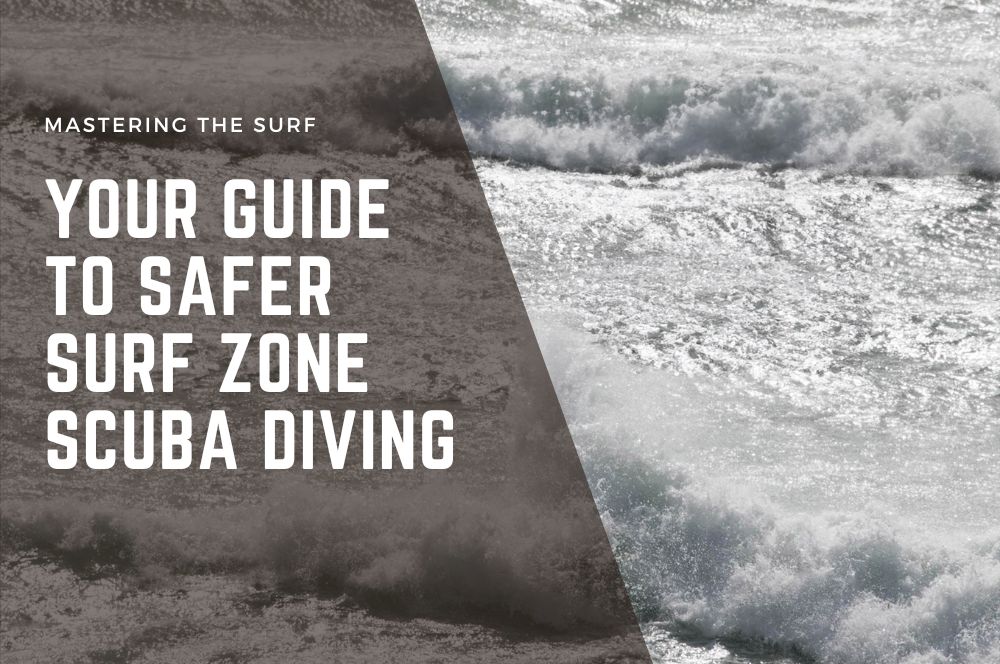
Mastering the Surf:…
Mastering the Surf: Your Guide to Safer Surf Zone Scuba Diving Facing the surf when scuba diving can be daunting, […] -
Sydney Diving Guide: Maximize Visibility…
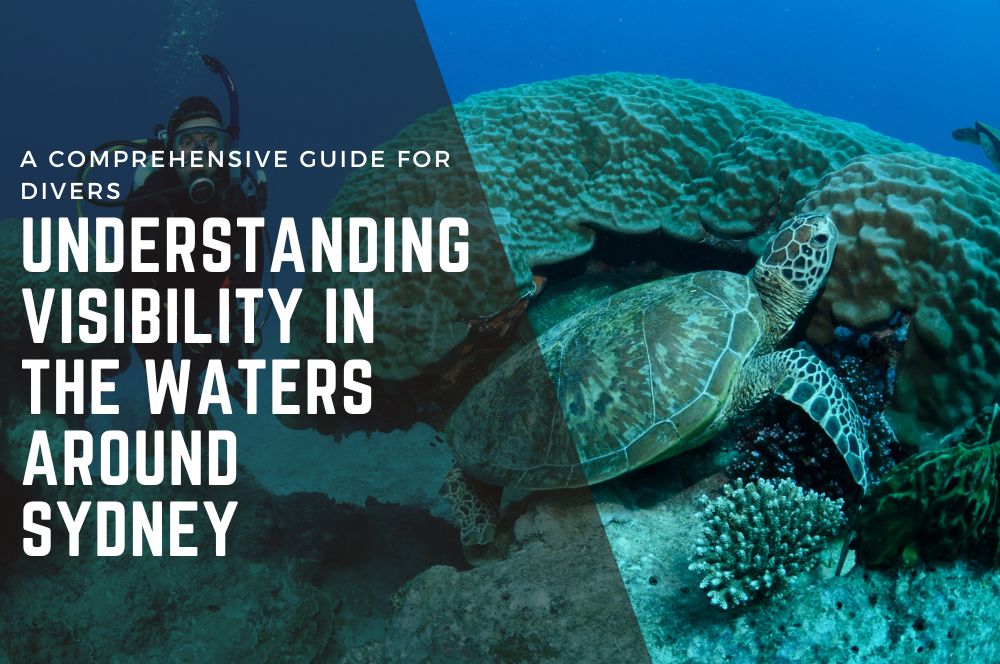
Sydney Diving Guide:…
Understanding Visibility in the Waters Around Sydney: A Comprehensive Guide for Divers Deetermine when the […] -
Sydney Diving Guide: Mastering Tides…
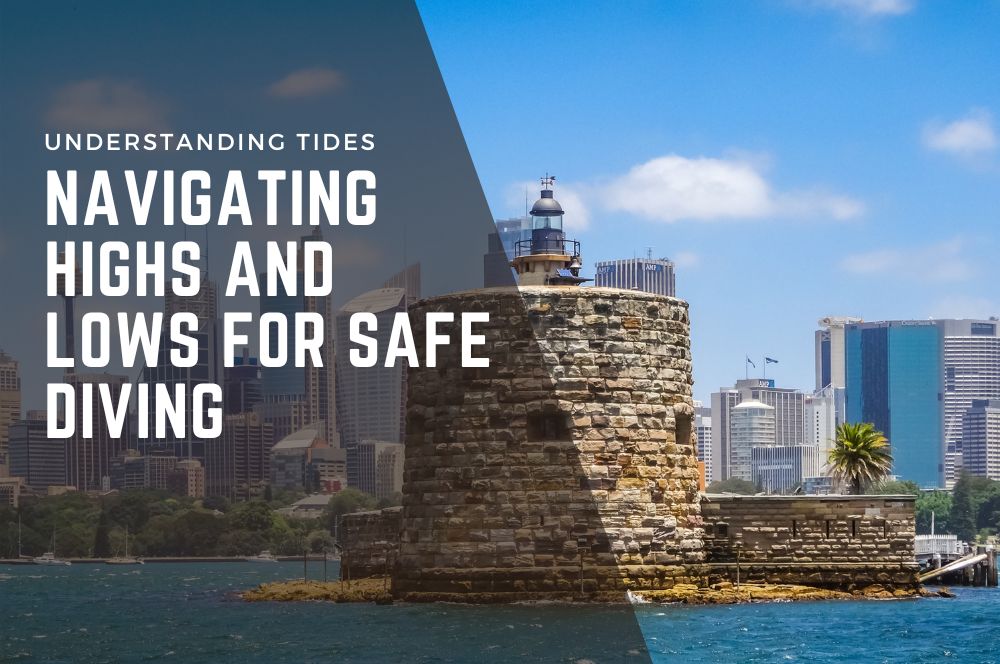
Sydney Diving Guide:…
Understanding Tides: Navigating Highs and Lows for Safe Diving Understanding ‘tide tides’ is […] -
Plunge into Scuba Diving: Pro Tips…
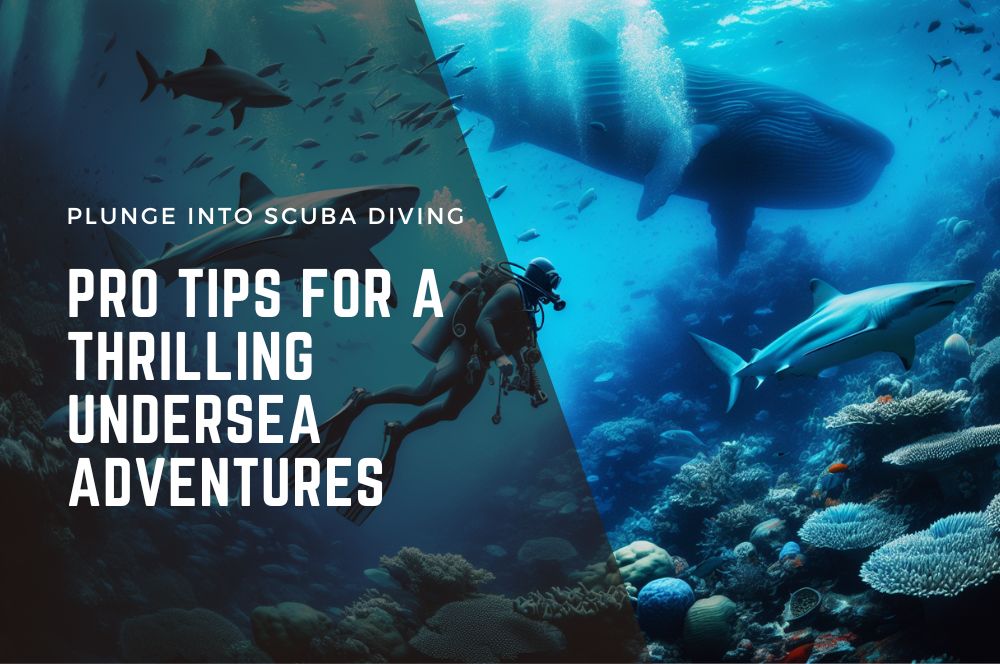
Plunge into Scuba Diving:…
Plunge into Scuba Diving: Pro Tips for a Thrilling Undersea Adventures Submerge into an exhilarating world […]
Recent Posts

